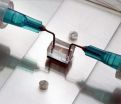Study of tiny magnets may advance their use in microelectronics
2010-10-20
(Press-News.org) Washington, D.C. (October 19, 2010) -- In the world of the very small, researchers at Shanxi University in China have announced progress in understanding the single-molecule magnet, which combines the classical macroscale properties of a magnet with the quantum properties of a nanoscale entity. In the Journal of Applied Physics, Hai-Bin Xue and colleagues studied the statistics of how electrons move through a single-molecule magnet to better understand the magnet's inner level structure.
Understanding the single-molecule magnet inner level structure is an important step toward the development of revolutionary ways to store and process information, as well as quantum computation. The results are important to the field of molecular spintronics, which combines molecular electronics with the field of spintronics -- the manipulation of spin and charge.
"The single-molecule magnet can be regarded as a magnetic quantum dot with a more complex level structure," says co-author Yi-Hang Nie, "which makes it a good candidate for molecular spintronics devices."
How electrons move through single-molecule magnets is not well understood. "The current-voltage characteristics of such a system are not known well enough for practical application," says co-author Hai Bin Xue. "Our results go significantly beyond earlier studies of magnetic molecules in general, for which the current noise has been studied very little. The predictions permit experimental tests in the near future."
###
The article, "Tunable electron counting statistics in a single-molecule magnet," by Hai-Bin Xue, Y.-H. Nie, Z.-J. Li, and J.-Q. Liang appears in the Journal of Applied Physics.
http://link.aip.org/link/japiau/v108/i3/p033707/s1
Journalists may request a free PDF of this article by contacting jbardi@aip.org
ABOUT JOURNAL OF APPLIED PHYSICS
Journal of Applied Physics is the American Institute of Physics' (AIP) archival journal for significant new results in applied physics; content is published online daily, collected into two online and printed issues per month (24 issues per year). The journal publishes articles that emphasize understanding of the physics underlying modern technology, but distinguished from technology on the one side and pure physics on the other. See: http://jap.aip.org/
ABOUT AIP
The American Institute of Physics is a federation of 10 physical science societies representing more than 135,000 scientists, engineers, and educators and is one of the world's largest publishers of scientific information in the physical sciences. Offering partnership solutions for scientific societies and for similar organizations in science and engineering, AIP is a leader in the field of electronic publishing of scholarly journals. AIP publishes 12 journals (some of which are the most highly cited in their respective fields), two magazines, including its flagship publication Physics Today; and the AIP Conference Proceedings series. Its online publishing platform Scitation hosts nearly two million articles from more than 185 scholarly journals and other publications of 28 learned society publishers.
END
ELSE PRESS RELEASES FROM THIS DATE:
2010-10-20
In a world first, a completely robotic surgery and anesthesia has been performed at the McGill University Health Centre (MUHC). The DaVinci surgical robot, which lets surgeons work from remote locations, was put to work this summer, whereas the anesthesia robot, nicknamed McSleepy, has been providing automated anesthesia since 2008. The two combined to perform the first all-robotic surgery on a prostatectomy patient at the Montreal General Hospital.
"Collaboration between DaVinci, a surgical robot, and anesthetic robot McSleepy, seemed an obvious fit; robots in medicine ...
2010-10-20
Princeton engineers have developed a sensor that may revolutionize how drugs and medical devices are tested for contamination, and in the process also help ensure the survival of two species of threatened animals.
To be fair, some of the credit goes to an African frog.
In the wild, the African clawed frog produces antibacterial peptides -- small chains of amino acids -- on its skin to protect it from infection. Princeton researchers have found a way to attach these peptides, which can be synthesized in the laboratory, to a small electronic chip that emits an electrical ...
2010-10-20
Outgoing. Assertive. Calm. Practical. Decisive. These are obvious qualities that one would want in their leaders.
But what about, say, arrogant, hesitant, overly dramatic, inflexible, or being a "yes-man"? A new study has found that when it comes to leading, some of those negative personality traits aren't such a bad thing, either.
The work, by researchers in the University of Nebraska-Lincoln's College of Business Administration, studied the development of leaders over a three-year period. Prior research had established that clearly positive personality qualities ...
2010-10-20
WASHINGTON, D.C., October 19, 2010—In response to a study regarding fish oil use during pregnancy published in the October 19 issue of the Journal of the American Medical Association (JAMA), the Council for Responsible Nutrition (CRN), the leading trade association for the dietary supplement industry, reminds pregnant and lactating women of the undisputed importance of consuming the recommended amounts of docosahexaenoic acid (DHA) throughout pregnancy. This can be done by eating two servings of fatty fish, such as sardines or anchovies, per week, or taking fish oil supplements ...
2010-10-20
The 2010 Nobel Prize in Physics went to the two scientists who first isolated graphene, one-atom-thick crystals of graphite. Now, a researcher with the University of Houston Cullen College of Engineering is trying to develop a method to mass-produce this revolutionary material.
Graphene has several properties that make it different from literally everything else on Earth: it is the first two-dimensional material ever developed; the world's thinnest and strongest material; the best conductor of heat ever found; a far better conductor of electricity than copper; it is virtually ...
2010-10-20
Athens, Ga. – When we make decisions based on what we think someone else will do, in anything from chess to warfare, we must use reason to infer the other's next move—or next three or more moves—to know what we must do. This so-called recursive reasoning ability in humans has been thought to be somewhat limited.
But now, in just-published research led by a psychologist at the University of Georgia, it appears that people can engage in much higher levels of recursive reasoning than was previously thought.
"In fact, they do it fairly easily and automatically," said Adam ...
2010-10-20
ANN ARBOR, Mich. – Millions worldwide die each year because they can't afford a pacemaker. Meanwhile heart patients in the United States say they'd be willing to donate theirs after death to someone in need.
In the current issue of Circulation, experts at the University of Michigan Cardiovascular Center examine the legality and logistics of collecting pacemakers, after they are removed for burial or cremation, for sterilization and reuse across the globe.
Small humanitarian efforts have shown reusing pacemakers is safe and effective with little risk of infection and ...
2010-10-20
Researchers at Yale School of Medicine have found that new disease pathways involving more than one cell type leads to Type 1 Gaucher disease, a rare genetic disorder in which fatty substances called glycosphingolipids accumulate in cells, resulting in liver/spleen enlargement, osteoporosis, bone pain, and increased risk of cancer and Parkinson's disease.
The new findings could lead to less expensive and more effective ways to treat the disorder, which affects about 1 in 50,000 people in the general population. Those of Eastern and Central European (Ashkenazi) Jewish ...
2010-10-20
A new report issued by the International Osteoporosis Foundation (IOF) for World Osteoporosis Day puts the spotlight on the severe impact of spinal fractures and calls on health professionals to recognize the signs of these fractures in their patients.
"The widespread under–diagnosis and lack of treatment of spinal fractures, leaves millions of people around the world with chronic pain, deformity, disability and at high risk of future fractures," says Professor John Kanis, President of the IOF.
As many as two-thirds of spinal osteoporotic fractures are not recognized ...
2010-10-20
GOLDEN, Colo. (October 20, 2010) – A new independent study by HealthGrades of patient outcomes at America's hospitals found that patients at 5-star rated hospitals had a 72% lower risk of dying when compared with patients at 1-star-rated hospitals -- an enormous gap that has held steady over the past years even as overall mortality rates have improved. According to the study, if all hospitals performed at the level of 5-star rated hospitals over the three years studied, 232,442 Medicare lives could potentially have been saved.
Released today, the Thirteenth Annual HealthGrades ...
LAST 30 PRESS RELEASES:
[Press-News.org] Study of tiny magnets may advance their use in microelectronics


